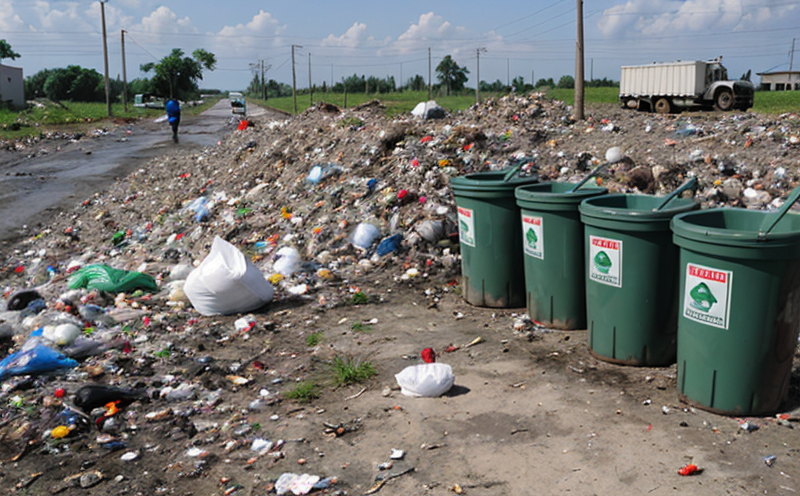ASTM D3987 Shake Extraction of Solid Waste Test
The ASTM D3987 Shake Extraction Test is a standardized method used to evaluate the leachability and extractable constituents from solid waste materials. This test is particularly relevant for waste management, recycling, and environmental protection sectors where the potential release of hazardous substances into the environment must be assessed.
This testing procedure is critical in ensuring compliance with regulatory standards such as those set by the Environmental Protection Agency (EPA), which aims to prevent harmful pollutants from entering water bodies or soil. The test involves subjecting a sample of solid waste to controlled shaking and extraction, simulating conditions that may occur during landfill leaching processes.
The primary purpose of this test is to determine the concentration levels of various chemicals present in the extractable fraction obtained after shaking. These include metals like lead (Pb), cadmium (Cd), and mercury (Hg) as well as other potentially harmful compounds such as dioxins, furans, and polychlorinated biphenyls (PCBs).
The ASTM D3987 test is widely recognized for its ability to provide accurate data on the leachability of hazardous substances from solid waste. It helps stakeholders in various industries make informed decisions regarding waste treatment methods, landfill design, and recycling processes.
For quality managers and compliance officers, understanding this test is essential as it plays a crucial role in ensuring that facilities meet regulatory requirements. R&D engineers can leverage the results of ASTM D3987 tests to develop safer materials and more efficient waste management strategies. Procurement professionals also benefit from knowing about such tests since they ensure that suppliers adhere to stringent environmental standards.
Why It Matters
The importance of the ASTM D3987 Shake Extraction Test cannot be overstated, especially in today's environmentally conscious world. By providing precise measurements of leachable substances within solid waste materials, this test helps prevent environmental pollution and supports sustainable practices.
- Prevents Pollution: Ensures that hazardous chemicals do not contaminate soil or water during landfill operations.
- Enhances Safety: Guarantees that products used in construction, manufacturing, and other industries are free from harmful contaminants.
The test results enable organizations to implement better waste management practices, leading to reduced risks associated with improper disposal methods. This not only benefits the immediate environment but also contributes positively towards global sustainability goals.
Moreover, compliance with such tests is often mandated by local and national governments as part of their efforts to protect public health and natural resources. Thus, conducting ASTM D3987 Shake Extraction Tests ensures that businesses remain in good standing with regulatory bodies.
Benefits
- Compliance Assurance: Helps organizations meet strict environmental regulations and standards set by agencies like the EPA.
- Risk Reduction: Identifies potential risks early on, allowing for preventive measures to be implemented promptly.
- Enhanced Reputation: Demonstrates commitment to responsible environmental stewardship which enhances corporate image among stakeholders.
The ASTM D3987 Shake Extraction Test offers numerous advantages beyond mere compliance. It provides valuable insights into the composition of solid waste materials, enabling informed decision-making regarding resource management and pollution prevention strategies.
By identifying hazardous components early in the process, this test allows for targeted interventions that can significantly reduce environmental impact. This proactive approach fosters a culture of sustainability within organizations while also contributing to broader societal benefits.
Industry Applications
- Waste Management: Assists in determining the leachability of hazardous substances from landfills and incineration facilities.
- Recycling Industries: Evaluates recycled materials to ensure they meet safety standards before being reintroduced into supply chains.
- Construction Sector: Helps assess the suitability of aggregate materials derived from demolition sites for use in new constructions projects without causing harm.
The ASTM D3987 Shake Extraction Test finds extensive application across multiple sectors. In waste management, it plays a vital role by providing data on the leachate composition from different types of solid waste materials stored at landfills or incinerated in controlled environments.
For recycling industries, this test ensures that recycled products such as plastics or metals comply with safety regulations before they enter markets. Similarly, in construction projects utilizing recycled aggregate materials like crushed concrete or asphalt shingles, ASTM D3987 can help verify the material's suitability for use without posing risks to human health or ecosystems.
These applications underscore the versatility and importance of the ASTM D3987 Shake Extraction Test across diverse industries. Its role extends beyond mere compliance; it serves as a tool for continuous improvement in environmental practices, ultimately contributing to more sustainable development pathways globally.





